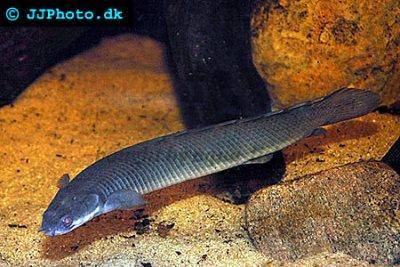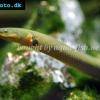Senegal bichir - Polypterus senegalus
Scientific name: Polypterus senegalus
Common name: Senegal bichir
Family: Polypteridae
Usual size in fish tanks: 20 - 30 cm (7.87 - 11.81 inch)
014
Recommended pH range: 6 - 7.5
Recommended water hardness: 4 - 18°N (71.43 - 321.43ppm)
0°C 32°F30°C 86°F
Recommended temperature range: 25 - 30 °C (77 - 86°F)
The way how these fish reproduce: Spawning
Where the species comes from: Africa
Temperament to its own species: peaceful
Temperament toward other fish species: peaceful
Usual place in the tank: Bottom levels
General Care
When setting up an aquarium for the Senegal Bichir (Polypterus senegalus), the key is to provide a tank with a large footprint rather than a deep one, as these fish are bottom-dwellers and don’t require much vertical space. A tank of at least 120 cm (48 inches) in length is recommended, allowing them ample room to explore. Low, flat tanks are ideal, but remember that Senegal Bichirs are excellent jumpers, so it’s crucial to use a tightly fitting lid to prevent escapes. Despite their poor eyesight, these fish rely heavily on their sense of smell to navigate and find food. Adding plants, rocks, and pieces of driftwood will provide necessary hiding spots and increase their confidence, reducing stress and promoting natural behaviors.
Although this species is generally peaceful, it is a predator by nature and will eat any tank mates small enough to fit in its mouth. When selecting tank mates, avoid small fish like tetras or guppies. Instead, pair them with larger, similarly peaceful species that occupy different levels of the tank, such as larger cichlids or catfish. It’s also important to avoid aggressive or highly territorial species that may stress the bichir.
Food and Feeding
Senegal Bichirs are carnivorous and should be provided with a protein-rich diet. Offer them a variety of meaty foods, including prawns, small pieces of filleted fish, and occasional meals of beef heart. They can also be fed frozen foods like bloodworms or krill, as well as high-quality carnivore pellets or sinking wafers. Avoid overfeeding, as these fish can become overweight if fed too frequently. Feed them once or twice a day, making sure any uneaten food is promptly removed to maintain water quality.
Senegal Bichirs may scavenge for food at the bottom of the tank, so ensure that sinking food is included in their diet. Additionally, while they will accept dried foods, they thrive best on a diet of fresh or frozen foods that mimic their natural prey.
Sexing
Sexing Senegal Bichirs can be challenging, but adult males can typically be distinguished by their broader anal fins. Males also tend to be more slender, while females are generally larger and more robust. These physical differences become more apparent as the fish mature. Observing their behavior during breeding attempts may also help differentiate the sexes, with males typically being more active and protective around potential spawning sites.
Breeding
Breeding Polypterus senegalus in captivity is rare but not impossible. This species is an egg scatterer, meaning the female will lay hundreds of eggs, which are then fertilized and scattered throughout the tank by the male. To encourage breeding, replicate their natural environment by adding dense planting and slightly lowering the water temperature. The male collects the eggs using his anal and caudal fins, fertilizes them, and scatters them around the tank, particularly in the plants. Removing the eggs to a separate tank is recommended, as the adults may eat them.
Once the eggs hatch, which typically takes 3-4 days, the fry remain inactive for several more days before becoming free-swimming. At this stage, they can be fed newly hatched brine shrimp or other suitable fry food. Ensure that food is placed close to the fry, as they may not be very active and could expend too much energy trying to find it.
Lifespan
Senegal Bichirs have an impressive lifespan, living 12 years or more with proper care. Key to their longevity is maintaining stable, high-quality water conditions, providing a nutritious diet, and ensuring that they are housed in a stress-free environment. Regular water changes and proper filtration are essential for keeping them healthy.
Origin
Polypterus senegalus is native to a wide range of freshwater habitats across Africa. They can be found in rivers, lakes, and floodplains, including the Nile River, Lake Chad, and the Senegal River. These fish are well-adapted to varying water conditions and are often found in slow-moving waters with abundant vegetation and hiding spots. In the wild, they use their ability to breathe atmospheric oxygen through their modified swim bladder to survive in oxygen-deprived environments, which can make them more resilient in captivity.
Short Description
The Senegal Bichir (Polypterus senegalus), also known as the dinosaur eel, is a unique and primitive species with an elongated, eel-like body and a distinctive serrated dorsal fin reminiscent of dinosaurs. Despite their appearance, they are not true eels. These fish are slow swimmers due to their small pectoral fins, which limits their predatory abilities. However, they possess a modified swim bladder, enabling them to breathe atmospheric oxygen, which allows them to survive in low-oxygen environments. Their peaceful nature and fascinating behavior make them a popular choice for experienced aquarists looking for something a little different.
Pictures
Bought by aqua-fish.net from jjphoto.dk. Also thanks to Jitka Kleteckova!









 Ropefish
Ropefish